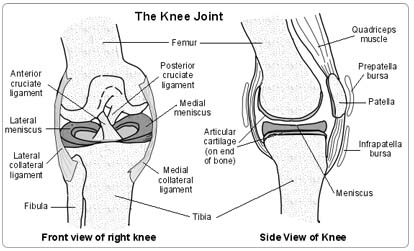What is it?
The surgeon needs to look inside your knee to find out exactly what is causing your problem.
- You may have a tear of one of your cartilages. These are half moon shaped pieces of gristle cushioning the bones in the knee.
- You may have torn one of the ligaments within your knee joint. These are strong bands of gristle holding the bone ends together inside the joint.
- You may have a loose piece of bone in your knee joint.
- You may have arthritis in part of your knee.
The Operation
You will have a general anaesthetic, and will be asleep for the whole operation. The arthroscope is a telescope about as wide as a pen, connected to a television. The surgeon will insert the arthroscope through one or two tiny cuts (about half an inch 1.2cm) around your knee. He will use it to look at the inside of your knee. This operation is called an arthroscopy. If you have torn a cartilage, he will remove the torn part using fine instruments inserted through small cuts. Occasionally he has to make a bigger cut to remove the cartilage. This would be about three inches (7.2cm) long. If you have torn a ligament within the knee, he will not replace it during this operation. He will discuss the possible treatments with you after your arthroscopy. If he finds a loose bone fragment, he will remove it through the small cuts. If you have arthritis, he can see how severe it is. He will wash out the knee with salt water. This often improves your symptoms for some months. The cuts will be closed with paper tapes or stitches. The operation can either be done as a day case, which means that you come into hospital on the day of the operation and go home the same day, or as an inpatient case, which means spending one night in hospital. Your surgeon will discuss with you which way you will be having the operation.

Any Alternatives
If you leave things as they are, the knee problem will probably get worse. More X-rays and scans will not help. Arthroscopy is the only way to give a direct view of the inside of the joint.
Before the operation
Stop smoking and get your weight down if you are overweight. (See Healthy Living.) Bring all your tablets and medicines with you to the hospital. On the ward, you may be checked for past illnesses and may have special tests, to make sure that you are well prepared and that you can have the operation as safely as possible.. Many hospitals now run special preadmission clinics, where you visit for an hour or two, a few weeks or so before the operation for these checks.
After - In Hospital
You will have a bandage on your knee. Usually the wound is pain-free but you may feel some discomfort and your knee may feel a bit stiff. This will quickly get better. You will be given painkillers to take home. They should easily control this discomfort. A general anaesthetic will make you slow, clumsy and forgetful for about 24 hours. The nurses will help you with everything you need until you are able to do things for yourself. Do not make important decisions, drive a car, use machinery, or even boil a kettle during this time. The cuts will be held closed with paper tapes or stitches. There will usually be simple adhesive dressings or a crepe bandage over the tapes. You may take the bandages, dressings and the tapes off 10 to 12 days or so after the operation. Wash around the dressing for the first 10 days. You can wash the wound area as soon as the dressing has been removed. Soap and warm tap water are entirely adequate. Salted water is not necessary. You can shower or take a bath as often as you like once the wound has healed. You will be given an appointment to visit the orthopaedic outpatient department 10 days or more after your operation. The nurses will advise about sick notes, certificates etc.
After - At Home
You will not be able to drive for two weeks after your operation. You will not be able to perform an emergency stop as quickly as normal before then. How soon you can return to work depends on your job. If you mainly sit at work, you may be able to return to work one week after your operation. This also depends on you being able to get to work. If your job is manual you will be unable to work for two or three weeks. You may swim and play most sports three weeks after your operation. When you start playing, you will not be able to play for as long as normal. Your knee may ache at the end of a game. You will gradually improve.
Possible Complications
As with any operation under general anaesthetic there is a very small risk of complications related to your heart or your lungs. The tests that you will have before the operation will make sure that you can have the operation in the safest possible way and will bring the risk for such complications very close to zero.
Complications are rare and seldom serious. Bleeding into the joint and infection of the joint may rarely happen after the arthroscopy. Sometimes a repeat operation is needed to remove a damaged cartilage. If there is arthritis, the operation may do no more than confirm this, without making the knee better.
More serious complications happen very rarely. You can develop a blood clot in one of your calf veins (deep vein thrombosis - DVT). This can be very dangerous because it can travel to your lungs which can be potentially lethal. You will be given medication (injection of blood thinners), and this in combination with the use of compression stockings and foot pumps, will protect you and help minimise the risk of DVT. In addition, during the operation further damage to the knee joint or damage to the nerves and blood vessels of the area can happen and this may require another operation to deal with the problem.
Advanced Reproductive Technology
- In Vitro Fertilisation (IVF)
- Intracytoplasmic Sperm Injection (ICSI)
- Donor egg and embryo programs
- In Vitro Fertilisation (IVF)
- Pre-implantation genetic diagnosis (PGD)
- Surrogacy programs
Dental Videos





